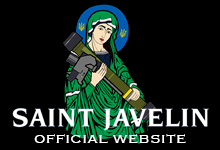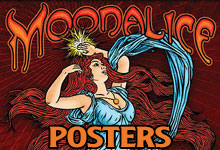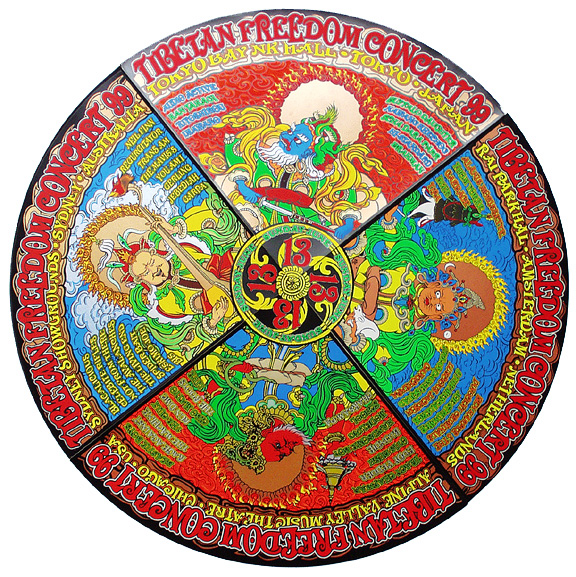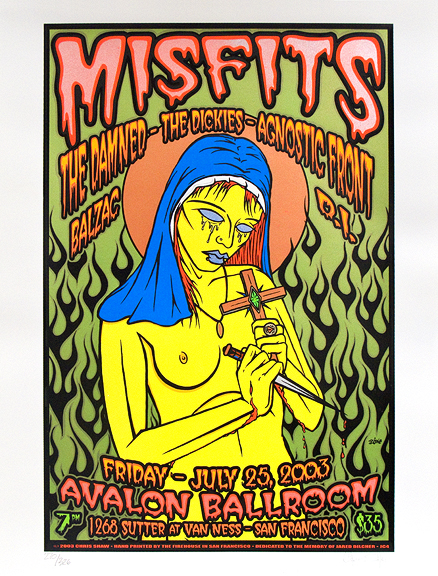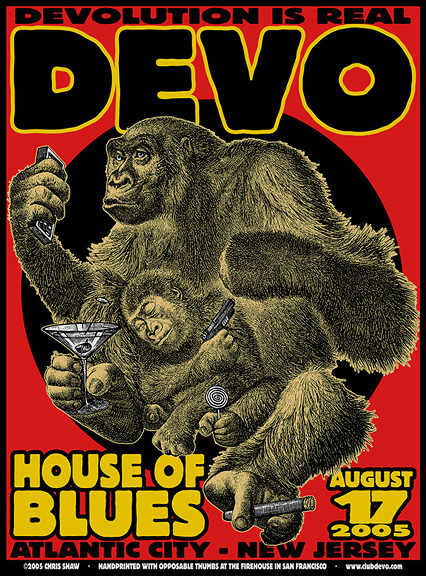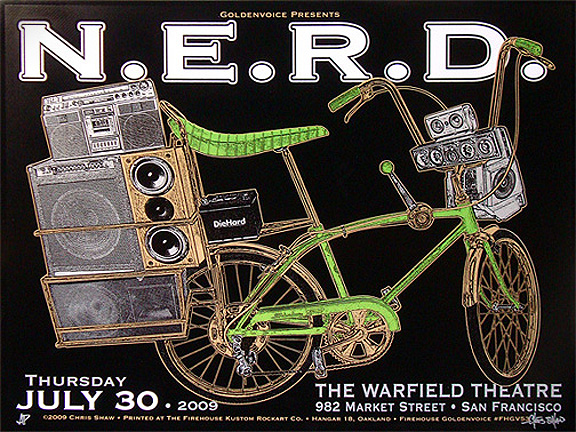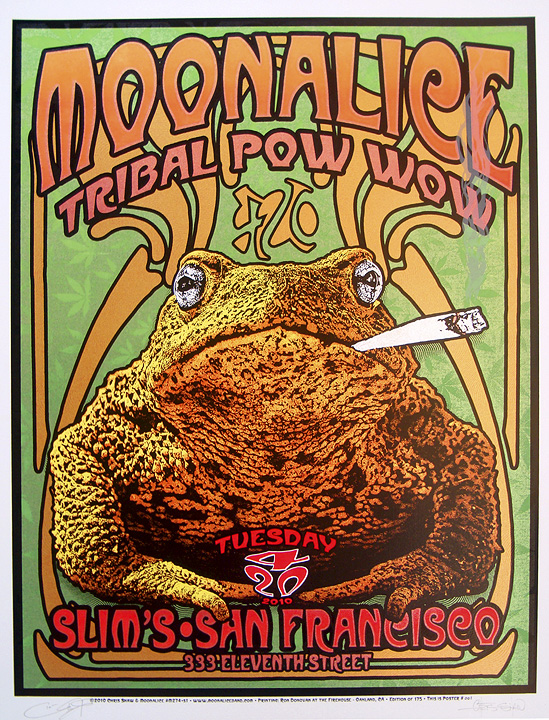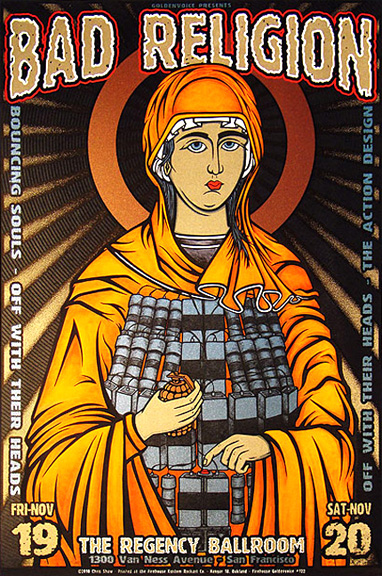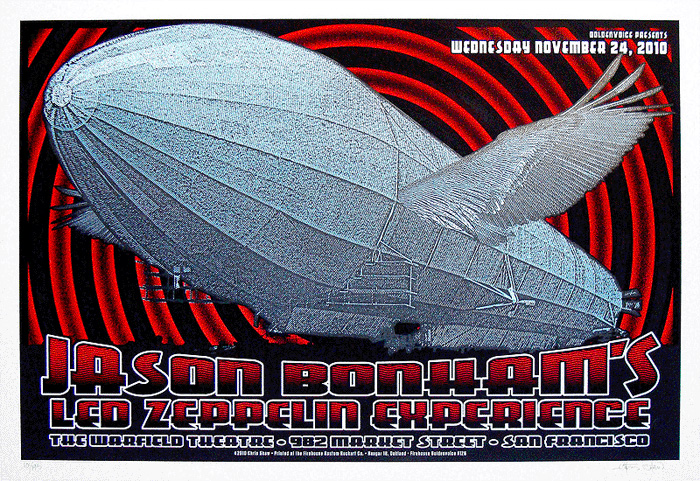Temporally Bound (Three Gorgons): An installation by Chris Shaw & Chuck Sperry
June 2012
Acrylic on 3 sections of 6 articulated hard-panels.
Each section measures 6’8″ x 12′ installed. (6’8″ h x 18′ flat.)
Chris Shaw and Chuck Sperry have been close friends for many years, but have only worked in tandem creating art on a handful of occasions. Both artists have both incorporated and appropriated concepts and imagery from a myriad of sources in their designs for Rock Posters and paintings.
“Temporally Bound” marks this collaboration by the two artists not only as an event, but also in the form and subject of the artwork. The work’s form is derived from an asian “accordion” book, while the subject, “Three Gorgons” reflects the artists’ western influences. The free intertwining of Eastern and Western references is not only evocative of the modern technological world, but also of San Francisco, a cultural melting pot on the Pacific Rim.
The installation is composed of 3 sections of 6 articulated hard panels, painted in acrylic and hand-made paints. The articulated form allows the artwork to bend or compress, the which lets the artwork take almost any form, in 2 or 3 dimensional space. Sperry and Shaw’s design concept for the Natoma Street windows called for an 18 foot wide horizontal image to compress into a 12 foot wide area. The artists chose wooden hard-panels for the installation substrate which creates a sturdy self-supporting structure with 52º angles, a golden proportion harmonious to the installation space.
In their experiences in creating Rock Posters, Shaw and Sperry had both worked previously with multi-panel poster images. When composing the “Three Gorgons” the artists paid special attention to the way the images would fragment when the panels were in their compressed and folded state. Because many of the viewers passing the installation on the sidewalk would be approaching at very oblique angles, the artists created semi-symmetrical images that would appear to change and unfold as the viewer passed by. Viewing the art at oblique angles and close proximity creates a distinct sense of “false abstraction”, while viewing the pieces from afar (the opposite sidewalk) gives the viewer cohesive, representational images of the Three Gorgons.
The 3 Gorgon images were created to work individually or together as a unit. In tandem, the artists each created their own distinct versions of a Gorgon (Shaw,left / Sperry, right). While each artist created their compositions and selected color individually, certain decisions were made together to help enhance the overall artwork when viewed in a unit. Red and Gold were both chosen as main color components, which again references Eastern art. The overall bold colors and hard graphic blackline of the Gorgons additionally reflects the artists work as poster artists and printmakers. Sperry and Shaw then worked together to create the 3rd, center Gorgon, a “hybrid” of their styles that would further bridge and integrate their individually created Gorgon panels.
Shaw’s Gorgon (left section) is a hard-line and sharp shadowed, woman’s face in pure yellow with pupil-less red metallic eyes. The Gorgon is accentuated by a headful of stylized gold snakes based on a pre-Inca Moche headdress. The symmetry in the face and forced perspective creates a distinct “Holbeinesque” optical illusion when viewed in the folded 52º state, as the face will appear to rotate as the viewer passes. Shaw’s work with large-scale stage art fostered an interest in the way large images can change when viewed at very oblique angles.
The center, “hybrid” Gorgon as a co-creation is a melding of the 2 artists ideas and styles. Shaw’s subtly rendered mother-of-pearl Gorgon’s face is accented with copper and black metal-flake paints. Sperry created the Gorgon’s prerequisite head of snakes, combining gold serpentine forms with linear rays of silver and copper. The two components of the image are seamlessly integrated with a bold blackline, characteristic of both artists’ work. This piece will also produce the optical illusion mentioned above as the viewer passes the artwork on the sidewalk.
Sperry’s highly textured Gorgon (right panel) evokes the paintings of Vienna Secession, primarily the work of Gustav Klimt, who is an influence in Sperry’s use of metallic pigments and textured layerings of paint. Sperry’s Gorgon offers a dynamic manifest investigation in painting of the styles and themes of the poster tradition.






















